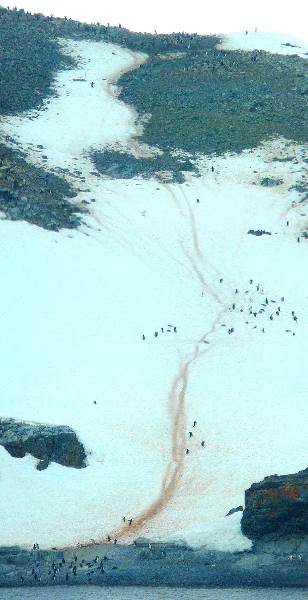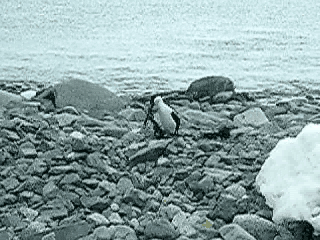The choice locations for a nest are the highest places that are the first to be clear of snow in the spring.
To reach these desirable sites may require a climb over snow fields and rocky cliffs.

The dot in the first picture is a single penguin all alone on a snow field.
We occasionally saw icebergs where a few had decided to get away from the crowd.
Chinstrap penguins
27 inches (70 cm.) and 10-11 pounds (5 kg)
The first of these pictures shows one carrying a pebble which will be used as part of its nest.
This one apparently survived an attack by a predator.
Probably a leopard seal or possibly a shark.
We were not supposed to get closer than 15 ft from the penguins.
Curious penguins apparently hadn't been told about the minimum approach rule.
Here is a video showing one checking out some human intruders.
Gentoo penguins
27-30 in. (68-71 cm.) and 12-13.5 pounds (5.5-6.2 kg.)
Their bright orange beak and feet are very distinctive.
If you just sit on the snow they will walk quite close to you.
The pebble nests guarantee that water running down from snow uphill doesn't touch their eggs.
Occasionally we would see one tobogganing on their belly but most preferred to walk.
Adelie penguins
27.5 in. (70 cm.) and 10-11 lb. (5 kg.)
Eggs and baby penguins
They seem to be playing in the water.
Antarctic Skua
Also known as the Brown Skua were seen hanging around several of the penguin colonies.
They resemble gulls as both are scavengers and opportunistic feeders.
We saw them fly in and cause a real uproar among the penguins.
On one occasion we captured pictures of one stealing an egg which it took a short distance away an ate.
The pair whose egg had been stolen followed but there was nothing that they could do.
It was apparent the the egg had been nearly ready to hatch.
Cormorant

Snowy sheathbill
We saw Weddell seals at several of our landings.
There were Fur seals as well.
And Elephant seals round out the list of the kinds we saw.
I think that this is a young Elephant seal.
I'm not sure what kind this is. They tend to look alike from this side.
We saw several hanging out on and around icebergs.
A whale spouting and then diving.
Unfortunately we only have mental pictures of the closest encounter when one swam alongside the ship.
The whale was just under the surface and nearly touching it.
It was so distinct it was hard for us to believe that it was real and not some sort of movie special effect.
Here are some pictures that look like they could use captions to explain what the penguins may have been thinking.
If you have a suggestion send me e-mail at kuehner@usa.net and tell me the number of the picture.
I will include the best ones when I update this page.
1)
3)
5)
7)
This pair need a combined caption
8)